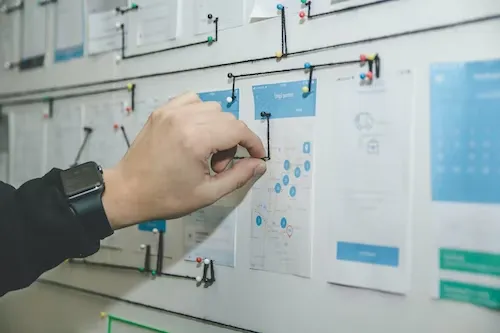Continuing education is crucial for surgeons to stay up-to-date with the latest techniques, technologies, and best practices. However, finding time for lengthy training sessions can be challenging, given a surgeon's demanding schedule. This is where microlearning can be very helpful. It offers a flexible, bite-sized approach to learning that is perfectly suited to the lifestyle of busy surgeons.
This guide will explain microlearning, its key benefits for surgeons, and how to implement a microlearning strategy effectively. Continue reading to understand how microlearning can enhance your career while fitting seamlessly into your daily routine.
Source: https://unsplash.com/photos/woman-wears-green-face-mask-qLzWvcQq-V8_ --- Photographer: Artur Tumasjan_
What is Microlearning?
Microlearning refers to consuming short bursts of educational content in 5--10 minute intervals. The core idea is that learning can be broken down into small, digestible chunks that are easy to fit into any spare moment in your day, such as during commute, lunch, or other small breaks.
Microlearning content is typically delivered via mobile apps, short videos, infographics, or flashcards, which are simple formats to engage with on the go. The short duration means you don't have to carve out large blocks of time for studying. All you need is 5 minutes to expand your knowledge over time through microlearning gradually.
Microlearning Content Ideas For Surgeons
When it comes to finding high-quality microlearning content, surgeons are truly spoiled for choice. Here are some of the top options to consider across various formats:
Surgical Technique Videos
Many eLearning Platforms offer extensive video libraries for all surgical specialties. For example, in a week, you can focus your e-learning on vascular surgery and quickly watch 2--5 minute clips perfect for microlearning. Watch surgical videos to review familiar procedures or learn about a new one. You can also make playlists tailored to your interests and continuing medical education (CME) needs.
Interactive Case Studies
Pushing the limits of what's possible with microlearning, some platforms present real patient scenarios and x-rays you can interact with on your schedule. You can work through a case, make decisions, and see outcomes --- all great for strengthening clinical judgment in short bursts.
Medical Journal Article Summaries
Sites like CMESphere, REBEL EM, and others publish brief 2--3 minute summaries and highlights of the most important studies. Scan summaries on your commute to filter for articles to read fully later. Some associations also offer weekly email roundups.
Conference Recap Podcasts
If you missed major conferences, listen to surgeon-hosted podcasts that recap the most practice-changing content in 10--15 minutes. Surgical podcasts like Behind the Knie and others ensure you're up-to-date with discoveries in the surgical field.
Interactive Flashcard Apps
Leverage spaced-repetition flashcard apps that allow the creation of custom flashcard decks on any topic. During your free time, drill into terminology, best practices, sutures, instruments, and more. Many of these apps also Integrate images for visual learners.
Infographics & Visual Guides
Many infographic sites distil complex surgical topics into beautifully designed one --- to two-page visual overviews. These can be referenced during pre-/post-op or between cases for quick review.
Implementing a Microlearning Strategy
The secret to success with microlearning is to thoughtfully plan how to incorporate it into your daily routine. With some upfront organisation, you can seamlessly integrate high-yield learning into all those small moments throughout your day.
Audit Your Schedule
Take the time to analyze a typical week of your schedule. Note when you have natural downtime like commuting, waiting between cases, or lunch. Also, consider times of day when your focus may be sharper, like early morning. Block these periods on your calendar specifically for microlearning to ensure consistency.
Curate Relevant Content
Spend 30 minutes each weekend hand-selecting top-quality microlearning resources directly related to your professional development goals and interests. Seek out multiple modalities like videos, articles, and flashcards for varied engagement. Save links, apps, etc., for easy access later.
Build Your Learning Playlists
Using the content you've curated, construct individualised playlists tailored to each micro-period in your schedule. For example, designate podcast episodes for your morning commute or journal article summaries for lunchtime. Organize by specialty, procedure type, or other filters.
Track Your Progress
Whether using the tracking features within apps or a simple spreadsheet, logging your completion of modules, articles, and other content keeps you accountable. Note topics for later review as needed. Always remember to celebrate your accomplishments.
Recommend to Peers
Sharing effective educational resources multiplies the benefits as you help colleagues strengthen their expertise as well. Post recommendations to specialty message boards or discuss them at your next journal club to spread the word.
Evaluate and Evolve
Periodically reassess your microlearning strategy. Genuinely check if it is still realistic, given evolving schedules. Note any topics you want to explore in more depth to refine future playlists. Continuous improvement ensures maximum learning impact over time.
With a little forethought and weekly maintenance, microlearning becomes seamlessly integrated into any surgeon's lifestyle for highly effective continual education on their terms.
Benefits of Microlearning for Surgeons
Here is why you should indulge in microlearning, especially as a surgeon:
- Flexibility: Microlearning allows you to learn whenever you have a spare moment, regardless of your schedule. You're not restricted to formal training sessions.
- Retention: Research shows breaking content into short segments aids retention compared to marathon study sessions. Our brains can only focus for 10--15 minutes at a time.
- Staying current: By learning a little daily, you can continually expand your expertise across multiple topics. This helps ensure you have the latest skills and information for optimal patient care.
- Portability: You can access content anywhere via your smartphone or tablet. Learn during your commute, lunch, or other moments away from your desk.
Microlearning also lets you squeeze learning into otherwise wasted time like waiting rooms or transit. You can further Switch between modalities like videos, articles, quizzes, etc., to maintain engagement and interest.
How To Measure the Impact of Microlearning
You need to closely track results to demonstrate microlearning's value and continually improve your strategy. Consider quantitative and qualitative metrics across professional, learning, and patient outcomes.
Professional Impact Metrics
- Participation in advanced training programs
- Adoption of the latest techniques/technologies
- Increased specialization & career progression
- Enhanced reputation as an innovator
Learning Metrics
- Performance on in-app/website assessments
- Feedback from mentors on clinical skills
- Engagement metrics from platforms used
- Self-rated confidence in applying knowledge
Patient Outcomes Metrics
- Post-op complication rates
- Length of hospital stay trends
- Patient satisfaction survey feedback
- Adoption of evidence-based best practices
Collect Outcomes Data
Leverage your hospital's patient databases to track metrics longitudinally. Note correlations between microlearning focus areas and changes in outcomes over time.
Conduct Pre/Post Evaluations
Administer brief pre/post quizzes or surveys yourself to measure knowledge and skills acquisition from your microlearning efforts directly.
Gather Qualitative Insights
Send a quick survey to colleagues, mentors and office staff to collect narratives on observed impacts. Personal stories can be highly persuasive.
Present Your Findings
Share the outcomes of your microlearning initiative at grand rounds or via a poster presentation. Publish a case report highlighting impacts. Consider presenting at your specialty's annual conference.
Use the above system to track the quantitative and qualitative results of your microlearning effort. This way, you can genuinely showcase microlearning's transformational impact on your career progression, skills mastery, and, most importantly, optimized patient care outcomes.
Conclusion
Microlearning clearly provides a highly effective solution for surgeons seeking to advance their expertise while maintaining a busy schedule. With a little planning and consistency, any surgeon can reap the benefits of this flexible, bite-sized approach to lifelong learning.


